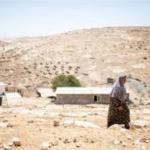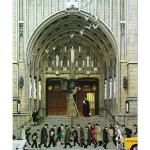GB Caird (The Revelation of St John the Divine) has a superb discussion of the harvest scene at the end of Revelation 14. He takes it not as a depiction of horrific judgment but rather as the harvest of the saints in martyrdom.
He points out that Jesus predicted that the coming of the Son of Man would be the moment when “He will send out his angels and gather his elect from the four winds, from one end of earth and heaven to the other” (Mark 13:27). When the Son of Man appears in a cloud in Revelation 14, it is time to start gathering in the saints. The noun and verb for harvest (therismos, therizo) are never used for “moving down of enemies” in the LXX and in the NT they are used only of gathering saints into the kingdom (190). The text leads us to expect this kind of harvest by identifying the 144,000 as “firstfruits” at the beginning of the chapter (v. 4), and Caird nicely observes that we have a firstfruits-full harvest pattern when we first meet the 144,000 in chapter 7: As soon as they are numbered, we see an innumerable multitude (191).
He then offers four arguments for saying that the harvest of the vintage is also “the ingathering of God’s servants” (192-3). First, the OT never uses vine imagery to describe judgment on Gentiles because “the vine was a traditional symbol of Israel,” taken over by Jesus (John 15). Second, the wine press in Revelation 14 is outside the city, which would be a nonsensical image if it referred to the trampling of the city’s inhabitants. It is, rather, the place of the cross and of martyrdom, as Hebrews 13:12-13 makes clear: “Whatever element of judgment is in the vintage, it is analogous to the judgment of the world achieved once for all on the Cross” (192).
Third, it may seem that the fact that the grapes are trampled in the “winepress of God’s wrath” is evidence against Caird’s interpretation, but he suggests that John “has made a logical connexion between three metaphors which in the OT were used independently: the vintage, the cup of wrath which God forces on the oppressor nation . . . and the land saturated, and therefore drunk, with blood. . . . A winepress may be a symbol for punishment, but it is also a place where grapes are made into wine.” Babylon is punished “when she is forced to drink the cup of God’s anger, and the winepress is not itself the punishment, but the place where the wine of God’s wrath was being prepared.” Babylon receives a double dose – a mix of her own impurities and of God’s retributive wine-blood (193).
Finally, there is the overall trajectory of this section of Revelation: “Chapter xiii ended with a threat of death to anyone who did not worship the statue of the monster or bear the number of his name. Chapter xv begins with a vision of the victorious martyrs. . . . It is natural to think that the intervening chapter has described the battle in which that freedom was won, and that it has been concerned with nothing else” (193).
All this means that the slaughter of the martyrs is not “simply the vindictive work of Babylon; it will also be the gracious work of the Son of Man, sending out his angels to reap a great harvest of souls, and incidentally to prepare the intoxicating cup that will prove the ruin of the mother of harlots” (193).














